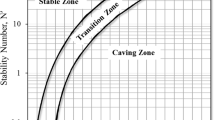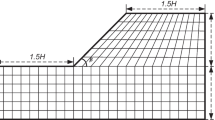Abstract
In the present study, the stability of a vertical rock escarpment is determined by considering the influence of undercut. Lower bound finite element limit analysis in association with Power Cone Programming (PCP) is applied to incorporate the failure of rock mass with the help of the Generalized Hoek-Brown yield criterion. The change in stability due to the presence of undercut is expressed in terms of a non-dimensional stability number (σci/γH). The variations of the magnitude of σci/γH are presented as design charts by considering the different magnitudes of undercut offset (H/vu and wu/vu) from the vertical edge and different magnitudes of Hoek-Brown rock mass strength parameters (Geological Strength Index (GSI), rock parameter (mi), Disturbance factor (D)). The obtained results indicate that undercut can cause a severe stability problem in rock mass having poor strength. With the help of regression analysis of the computed results, a simplified design equation is proposed for obtaining σci/γH. By performing sensitivity analysis for an undisturbed vertical rock escarpment, we have found that the undercut height ratio (H/vu) is the most sensitive parameter followed by GSI, undercut shape ratio (wu/vu), and mi. The developed design equation as well as design charts can be useful for practicing engineers to determine the stability of the vertical rock escarpment in the presence of undercut. Failure patterns are also presented to understand type of failure and extent of plastic state during collapse.
Similar content being viewed by others
Change history
22 July 2023
A Correction to this paper has been published: https://doi.org/10.1007/s11709-023-0035-5
References
Sunamura T. Geomorphology of rocky coasts. Coastal Morphology and Research, 1994, 3: 174–175
Budetta P, Galietta G, Santo A. A methodology for the study of the relation between coastal cliff erosion and the mechanical strength of soils and rock masses. Engineering Geology, 2000, 56(3–4): 243–256
Abderahman N. Evaluating the influence of rate of undercutting on the stability of slopes. Bulletin of Engineering Geology and the Environment, 2007, 66(3): 303–309
Chu-Agor M L, Fox G A, Cancienne R M, Wilson G V. Seepage caused tension failures and erosion undercutting of hillslopes. Journal of Hydrology (Amsterdam), 2008, 359(3–4): 247–259
Mirenkov V E. On probable failure of an undercut rock mass. Journal of Mining Science, 2009, 45(2): 105–111
Young A P, Guza R T, O’Reilly W C, Hansen J E, Barnard P L. Short-term retreat statistics of a slowly eroding coastal cliff. Natural Hazards and Earth System Sciences, 2011, 11(1): 205–217
Katz O, Mushkin A. Characteristics of sea-cliff erosion induced by a strong winter storm in the eastern Mediterranean. Quaternary Research, 2013, 80(1): 20–32
Budetta P, Luca C D. Wedge failure hazard assessment by means of a probabilistic approach for an unstable sea-cliff. Natural Hazards, 2015, 76(2): 1219–1239
Ukritchon B, Ouch R, Pipatpongsa T, Khosravi M H. Investigation of stability and failure mechanism of undercut slopes by three-dimensional finite element analysis. KSCE Journal of Civil Engineering, 2018, 22(5): 1730–1741
Augustinus P C. Rock mass strength and the stability of some glacial valley slopes. Zeitschrift für Geomorphologie, 1995, 39(1): 55–68
Tsesarsky M, Hatzor Y H, Leviathan I, Saltzman U, Sokolowksy M. Structural control on the stability of overhanging, discontinuous rock slopes. In: Alaska Rocks, 40th US Symposium on Rock Mechanics (USRMS). Anchorage, AK: American Rock Mechanics Association, 2005
Briaud J L. Case histories in soil and rock erosion: Woodrow Wilson bridge, Brazos River Meander, Normandy Cliffs, and New Orleans Levees. Journal of Geotechnical and Geoenvironmental Engineering, 2008, 134(10): 1425–1447
Tsesarsky M, Hatzor Y H. Kinematics of overhanging slopes in discontinuous rock. Journal of Geotechnical and Geoenvironmental Engineering, 2009, 135(8): 1122–1129
Hayakawa Y S, Matsukura Y. Stability analysis of waterfall cliff face at Niagara Falls: An implication to erosional mechanism of waterfall. Engineering Geology, 2010, 116(1–2): 178–183
Budetta P. Stability of an undercut sea-cliff along a cilento coastal stretch (Campania, Southern Italy). Natural Hazards, 2011, 56(1): 233–250
Banerjee S K, Chakraborty D. Influence of undercut and surface crack on the stability of a vertical escarpment. Geomechanics and Engineering, 2017, 12(6): 965–981
Hoek E, Carranza-Torres C, Corkum B. Hoek-Brown failure criterion—2002 edition. Proceedings of NARMS-Tac, 2002, 1(1): 267–273
Hoek E, Brown E T. The Hoek-Brown failure criterion and GSI-2018 edition. Journal of Rock Mechanics and Geotechnical Engineering, 2019, 11(3): 445–463
Merifield R S, Lyamin A V, Sloan S W. Limit analysis solutions for the bearing capacity of rock masses using the generalised Hoek-Brown criterion. International Journal of Rock Mechanics and Mining Sciences, 2006, 43(6): 920–937
Li A J, Merifield R S, Lyamin A V. Effect of rock mass disturbance on the stability of rock slopes using the Hoek-Brown failure criterion. Computers and Geotechnics, 2011, 38(4): 546–558
Kumar J, Mohapatra D. Lower-bound finite elements limit analysis for Hoek-Brown materials using semidefinite programming. Journal of Engineering Mechanics, 2017, 143(9): 04017077
Kumar J, Rahaman O. Lower bound limit analysis of unsupported vertical circular excavations in rocks using Hoek-Brown failure criterion. International Journal for Numerical and Analytical Methods in Geomechanics, 2020, 44(7): 1093–1106
Das S, Chakraborty D. Effect of interface adhesion factor on the bearing capacity of strip footing placed on cohesive soil overlying rock mass. Frontiers of Structural and Civil Engineering, 2021, 15(6): 1494–1503
Das S, Chakraborty D. Effect of soil and rock interface friction on the bearing capacity of strip footing placed on soil overlying Hoek-Brown rock mass. International Journal of Geomechanics, 2022, 22(1): 04021257
Das S, Halder K, Chakraborty D. Bearing capacity of interfering strip footings on rock mass. Geomechanics and Geoengineering, 2022, 17(3): 883–895
Lysmer J. Limit analysis of plane problems in soil mechanics. Journal of the Soil Mechanics and Foundations Division, 1970, 96(4): 1311–1334
Sloan S W. Lower bound limit analysis using finite elements and linear programming. International Journal for Numerical and Analytical Methods in Geomechanics, 1988, 12(1): 61–77
Sloan S W. Geotechnical stability analysis. Geotechnique, 2013, 63(7): 531–571
Makrodimopoulos A, Martin C. Lower bound limit analysis of cohesive-frictional materials using second-order cone programming. International Journal for Numerical Methods in Engineering, 2006, 66(4): 604–634
Krabbenhøft K, Lyamin A V, Sloan S W. Three-dimensional Mohr-Coulomb limit analysis using semidefinite programming. Communications in Numerical Methods in Engineering, 2008, 24(11): 1107–1119
Kumar J, Rahaman O. Lower bound limit analysis using power cone programming for solving stability problems in rock mechanics for generalized Hoek-Brown criterion. Rock Mechanics and Rock Engineering, 2020, 53(7): 3237–3252
Chakraborty D, Kumar J. Stability of a long unsupported circular tunnel in soils with seismic forces. Natural Hazards, 2013, 68(2): 419–431
MATLAB. Version 8.5. Natick, MA: MathWorks, 2015
MOSEK ApS. Version 9.0. Copenhagen: MOSEK, 2020
Michalowski R L, Park D. Stability assessment of slopes in rock governed by the Hoek-Brown strength criterion. International Journal of Rock Mechanics and Mining Sciences, 2020, 127: 104217
Rabczuk T, Zi G, Bordas S, Nguyen-Xuan H. A simple and robust three-dimensional cracking-particle method without enrichment. Computer Methods in Applied Mechanics and Engineering, 2010, 199(37–40): 2437–2455
Rabczuk T, Belytschko T. Cracking particles: A simplified meshfree method for arbitrary evolving cracks. International Journal for Numerical Methods in Engineering, 2004, 61(13): 2316–2343
Rabczuk T, Belytschko T. A three-dimensional large deformation meshfree method for arbitrary evolving cracks. Computer Methods in Applied Mechanics and Engineering, 2007, 196(29–30): 2777–2799
Areias P, Reinoso J, Camanho P P, de Sá J C, Rabczuk T. Effective 2D and 3D crack propagation with local mesh refinement and the screened Poisson equation. Engineering Fracture Mechanics, 2018, 189: 339–360
Areias P, Rabczuk T. Steiner-point free edge cutting of tetrahedral meshes with applications in fracture. Finite Elements in Analysis and Design, 2017, 132: 27–41
Areias P, Msekh M A, Rabczuk T. Damage and fracture algorithm using the screened Poisson equation and local remeshing. Engineering Fracture Mechanics, 2016, 158: 116–143
Ren H, Zhuang X, Rabczuk T. A higher order nonlocal operator method for solving partial differential equations. Computer Methods in Applied Mechanics and Engineering, 2020, 367: 113132
Zhuang X, Ren H, Rabczuk T. Nonlocal operator method for dynamic brittle fracture based on an explicit phase field model. European Journal of Mechanics. A, Solids, 2021, 90: 104380
Acknowledgements
This work used the Supercomputing facility of IIT Kharagpur established under National Supercomputing Mission (NSM), Government of India, and supported by Centre for Development of Advanced Computing (CDAC), Pune.
Author information
Authors and Affiliations
Corresponding author
Appendices for
11709_2022_841_MOESM1_ESM.pdf
Effect of undercut on the lower bound stability of vertical rock escarpment using finite element and power cone programming
Rights and permissions
About this article
Cite this article
Das, S., Chakraborty, D. Effect of undercut on the lower bound stability of vertical rock escarpment using finite element and power cone programming. Front. Struct. Civ. Eng. 16, 1040–1055 (2022). https://doi.org/10.1007/s11709-022-0841-1
Received:
Accepted:
Published:
Issue Date:
DOI: https://doi.org/10.1007/s11709-022-0841-1




